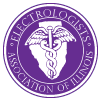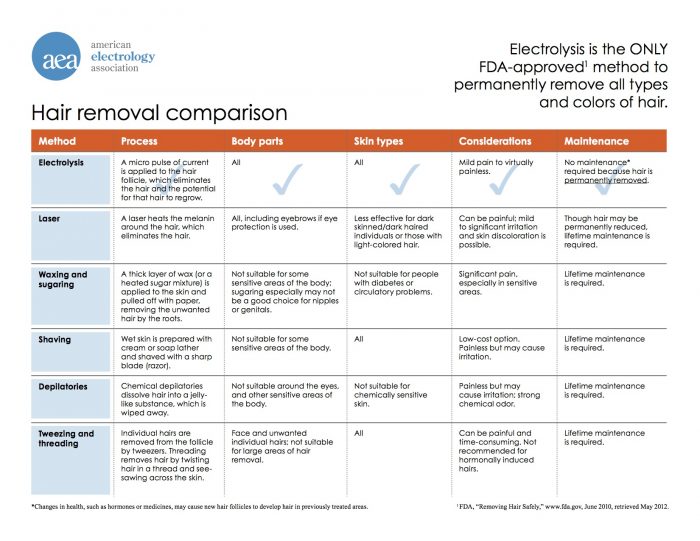Is electrolysis right for me?
You may feel like you are alone in having unwanted hair, but you’re really not. Believe it or not, your hair problems are probably typical. There are many reasons people – both men and women – turn to electrolysis as the best way to remove hair. No matter what the specific problem area, age, gender, hair or skin type, hair color or skin color – you have plenty of company and electrolysis can help. Every day, people just like you choose electrolysis as a permanent, safe, and effective solution.
Electrolysis for athletes
For athletes
In athletic competition, even a fraction of a second can make a difference. A streamlined profile can cut down on wind or water friction, provide a comfortable “feel” during athletic activity and make hygiene easier. Experts also say that athletes who participate in a sport which produces chafing could find some relief through hair removal.
The trend of widespread body hair removal, from back to arm and leg hair to the pubic region—even going totally bare—is most common among swimmers, cyclists and triathletes.
Athletes who turn to hair removal for improved athletic performance may choose to commit to weekly upkeep. But for those who would like the convenience of a permanent solution, electrolysis is the only effective option. Other methods may reduce the amount of hair but only electrolysis provides permanent hair removal..
Discuss your goals with your professional electrologist to develop a hair removal plan that meets your needs.
Where can I get more information about electrolysis?
Answers to general questions about electrolysis are available on the FAQ page.
Electrolysis for breasts and sensitive areas
For breast and sensitive areas
Professionally performed electrolysis safely and permanently eliminates unwanted hair from the breasts and other sensitive areas with unsurpassed results.
Do women ever have electrolysis treatments on their breasts?
Yes, this is a very common area of unwanted hair for women of all ages. However, the subject is seldom discussed, as most women find it extremely difficult to talk about. Electrolysis treatments can safely and permanently remove breast hairs.
Can hairs around the nipple be removed?
Yes, all hairs can be removed from the breasts; it is not unusual to have hair growing from the areola.
Does it hurt there?
While the breasts are sensitive to touch, they are not so sensitive to the sensation of electrolysis treatments. Most women are highly motivated to have the hair on their breasts removed and accept the treatments quite well.
I’ve been tweezing those hairs for a long time. How many treatments will it take?
Tweezing does cause hairs to become coarser over time and it hides the true amount of hair you have. All the hairs must grow out before they can be permanently removed, so it is impossible for the electrologist to tell you exactly how many treatments you will need. Be sure to follow the electrologist’s recommended schedule of treatments. This is essential in achieving permanency as quickly as possible.
I’ve got a lot of ingrown hairs on my breasts. Will that be a problem?
Repeated tweezing and shaving, plus the fact that clothes are sometimes worn tight over this area, can contribute to hairs being trapped beneath the skin. Ingrown hairs can successfully be eliminated; in time, this will alleviate any irritation you may have experienced.
If I’m pregnant, can I have electrolysis treatments on my breasts?
It is generally advised that a woman should not have breast treatments during the last trimester of her pregnancy.
Where can I get more information about electrolysis?
Answers to general questions about electrolysis are available on the FAQ page.
Electrolysis for curly, wavy, and coarse hair
For curly, wavy or coarse hair
Have you been told that your hair type or skin tone is the reason you are not a candidate for hair removal treatment? You should speak to a professional electrologist, because not only is electrolysis safe and effective for all types of hair and skin tones, it’s also the only treatment that removes hair permanently.
Why is curly or coarse hair a problem?
Curly hair is more prone to become ingrown or cause raised bumps on your skin. Coarse hair gets stuck underneath the skin. Attempting to manage these problems by temporary methods such as depilatories, shaving, or tweezing can just make them worse, causing scarring or discolored areas. These methods are very hard on your skin.
Who has curly, wavy or coarse hair?
If you have dark skin, you have a higher likelihood of having this type of facial or body hair, but it can appear with any skin tone. Straight hair can also become ingrown.
What does electrolysis do about it?
Electrolysis safely and permanently removes ingrown hairs and the curly, coarse hairs that tend to damage your skin without creating issues that occur with tweezing and other temporary methods of hair removal.
Electrolysis for dark skin
For darker skin
Dark skin is a challenge for some hair removal methods, but not for electrolysis. If you’ve heard that your skin tone means that you are not a candidate for hair removal treatments, then you need to speak to an electrolgist. Electrolysis is effective on all skin colors and types of hair.
Does electrolysis work on dark skin?
Yes. Your electrologist looks for the opening where the hair emerges from the skin. They do not need a significant difference in between the color of the hair and the color of your skin to do this. No matter what color of skin and hair you have, electrolysis works.
Will electrolysis treatment cause dark spots on my skin?
Temporary hyperpigmentation (dark spots) is the darker skin equivalent of the temporary redness sometimes experienced by those with lighter skin. If you have been tweezing the hair, the irritation from that can also cause dark spots. These dark spots are a sign that the skin is doing it’s job and healing the irritated area; they will fade over time. Do not use a bleaching cream on these areas as this can cause light spots (hypopigmentation) when the skin returns to normal. Your electrologist can recommend an aftercare product to help speed the return to normal pigmentation.
What if an electrologist says they don’t work on dark skin?
Electrologists have specialties and areas of expertise, just like other practitioners. If you speak to an electrologist who does not work on dark skin, ask them for a referral to someone who does.
Why is the electrologist asking me about my pierced ears?
Darker skin is more prone to a special type of scarring called keloids. Your electrologist may ask you about things like piercings or vaccination scars to determine if you are prone to keloids, so that they can make the appropriate adjustments to your treatment plan.
Where can I get more information about electrolysis?
Answers to general questions about electrolysis are available on the FAQ page.
Electrolysis for hormone imbalance or PCOS
For hormonal imbalance or PCOS
Throughout women’s lives, hormones fluctuate and can cause hair to grow unexpectedly.
Hormonal changes and conditions account for many problems besides unwanted hair. The cause can be related to puberty, menopause, pregnancy, Polycystic Ovary Syndrome (PCOS), an underlying medical condition, your genetic makeup and even some medications. You may want to see an endocrinologist to get a proper diagnosis and treatment. For the hair, the solution is electrolysis.
All of a sudden I started sprouting these coarse hairs on my chin. I am only 40 years old. What’s wrong with me?
At your consultation, your electrologist will take a thorough health history. This will help them figure out a possible reason why this hair came on suddenly. Among the questions will be:
Do you have thyroid problems?
Are you diabetic?
Have you had menstrual or ovarian problems?
What medications do you take?
Do you have a family history of unwanted hair?
Some studies show women have symptoms of menopause 10 years before they reach menopause. This also could be the cause.
Electrologists cannot diagnose, but they can ask you questions that will help you have further discussions with your physician. Regardless of the cause, your electrologist can permanently remove the unwanted hair.
I have always had a lot of facial hair. I thought I was the only one, but now I am beginning to wonder – are there others like me?
There are many of us with unwanted hair. In fact, most likely, your electrologist has spent many hours receiving electrolysis treatments. Their compassion comes from walking in your shoes. There seems to be more of us with unwanted hair than without!
Every doctor I have seen tells me to “just lose some weight” and my periods will become normal. As hard as I try, I just can’t seem to lose weight. Plus I have all this hair all over my face and breasts and belly, so I have trouble changing at the gym. What is wrong?
An endocrinologist (hormone specialist) may be the person to help you. When women are overweight, have trouble losing weight, have irregular or no periods, and hair in the male pattern area (which you have described), they should be evaluated by a specialist. These are classic signs of Polycystic Ovary Syndrome (PCOS).
Again, electrologists cannot diagnose, but they do recognize what is not normal. If you have PCOS, your electrologist can permanently remove the unwanted facial and body hair.
What is the treatment for Polycystic Ovary Syndrome (PCOS)?
Treatment depends on the symptoms. Your primary physician or endocrinologist can determine the best course of action to alleviate specific symptoms you have. If weight is an issue, the most successful eating pattern is following a diabetic healthy eating plan. When choosing carbs, make sure they are complex carbs that don’t raise your blood sugar.
If you develop unwanted hair, electrolysis will get rid of the unwanted hair permanently. To address the medical issues, sometimes medications are prescribed by your physician.
I went to see the endocrinologist and she said all my tests came back normal. How can that be with all this hair on my face?
Dr. Jeffrey Redmond, a NY endocrinologist, has told the electrology profession that some people’s bodies are more sensitive to circulating hormones. So just because your blood levels have come back “normal,” it does not mean that they are normal for YOU! As hard as it may seem, go back and have another conversation with your endocrinologist. We must each be an active advocate for our own health.
I have both acne and chin hair. Will electrolysis help?
Chin hair on women is often exacerbated by tweezing and waxing. The repeated irritation from yanking hairs out can result in a larger diameter hair growing from the follicle or ingrown hairs from the breaking off of hairs in the follicle. When women tweeze hairs from their chin and have acne on their chin, but not on the rest of their face, they should find relief from their acne with electrolysis treatments.
Once they have stopped tweezing hairs from the chin and allow the electrologist to properly treat the hair, skin will clear. Hormonally caused facial hair on women usually grows in a pattern, starting with the chin and corners of the upper lip.
What medications cause hair growth?
Many medications can cause hair growth or hair loss. Talk with your pharmacist about each medication you are on and also about how your medications interact.
Where can I get more information about electrolysis?
Answers to general questions about electrolysis are available on the FAQ page.
Electrolysis for men
For men
A well groomed appearance is important in business as well as socially. Beyond that, some men just naturally have too much body hair for their own sense of style or their partner’s aesthetic taste.
If you’re not someone who cheerfully puts up with a time-consuming hair maintenance routine, you’ve found the permanent hair removal solution for men: electrolysis.
What areas of the body can be treated with electrolysis?
Back hair and ear hair come to mind, but other areas are part of the “manscaping” process. Some common areas of treatment are: eyebrows, especially if a unibrow is of concern; beard sculpting, to eliminate shaving on the cheeks and neck; neckline hair, to treat skin irritations and ingrown hairs; ear hair; back hair and shoulder hair. Competitive athletes also choose electrolysis for permanent removal of unwanted body hair.
How long will it take?
The length of a treatment, and the number of treatments to complete the process, will depend on the amount of hair to be removed. Defining brows or treating ears will take a lot less time than removing the heavy growth on a back. It is important to know that consistent clearings, of any area, will achieve permanence sooner than having sporadic appointments.
How long is each treatment session?
Treatment sessions can range from 15 minutes to more than an hour, depending on the area being treated. Based on a thorough and confidential consultation, a professional electrologist will provide you with a tailored treatment plan that will address your specific areas of concern.
How do I know that I’m getting good treatments?
The electrologist should explain all aspects of the treatments, recommend a treatment schedule that will help you accomplish your hair removal goals, and explain how you should take care of the treated skin.
Generally speaking, you should not feel the insertion of the probe into the hair follicle, nor should you feel like the hair is being pulled out when it is removed; the hair will usually slide out of the follicle when properly treated. You skin will likely be red after treatment. The redness should dissipate within the day. Your skin should not be unduly irritated and will heal normally if a few precautions are taken, as should be discussed during your consultation. If you have any questions, the electrologist should be happy to answer them to your satisfaction.
Can hairs around the groin or on the genital area be treated?
Hair can be safely and effectively removed from the groin and genital area. However, not all electrologists choose to work in these areas. Of those who do, some will require that you have other areas treated first, while others will require a medical referral before starting treatments. A professional electrologist should be able to refer you to a colleague if they do not treat these areas.
How do I find an electrologist who will work on these areas?
Find an AEA member electrologist near you. Call or email them to ask what requirements they have for treating the groin or genitals.
Where can I get more information about electrolysis?
Answers to general questions about electrolysis are available on the FAQ page.
Electrolysis for teenagers
For teens
As teens are coming into their own, physical changes such as unsightly hair can negatively impact body image and self-esteem. For teenage girls, it could be the growth of superfluous hair on the side of the face. For teenage boys, it may be the emergence of thick, bushy eyebrows. Some teenagers feel too embarrassed to speak about their hair concerns, while others go to a parent for advice.
If you’re a teen or the parent of a teen, rest assured that there is a permanent solution for removing excess hair safely, comfortably and conveniently: electrolysis.
What is the youngest age for electrology treatments?
The earliest age for treatment depends upon the motivation of the young person. Most electrologists want to make sure that it’s the young person, and not a parent, who is deciding that it’s time for electrology treatments. Girls as young as 12 seek treatments to remove hair on their upper lip. Teens and even pre-teens of both genders receive treatments to define or separate eyebrows.
Can young people tolerate the treatments?
Yes, new techniques, equipment and topical anesthetics help reduce the sensation of electrology treatments. A tolerance for the treatments will also come with maturity. If the young person decides not to have treatments, the electrologist will discuss options to hide the hair until he or she is less sensitive.
Tana Case StudyTana’s personal journey began when she was teased at school for her excessive hair growth.
Read Tana’s Story
If the young person is too sensitive, what other options are there?
Cutting, clipping, or shaving are the best ways to hide the hair (it will not result in coarsening or increased density). Bleach will hide scattered hairs, to a degree. Depilatories remove the hair with chemicals, although they can cause irritation, possibly resulting in skin pigmentation problems.
Teen and pre-teen girls often get treatments on their upper lip, chin and sides of face. Young women and men will also have their eyebrows defined or separated, as well as hairline, neckline and body areas treated.
Why do young girls grow hair on their upper lip?
Genetics, hormones, and medications can cause hair growth at any age. Most people never learn the cause of their excess hair growth and accept the fact that electrology treatments are the solution to this universal problem.
Where can I get more information about electrolysis?
Answers to general questions about electrolysis are available on the FAQ page.

TG-Friendly by
Laura’s Playground

American Electrology
Association

Electrologists Association
of Illinois



